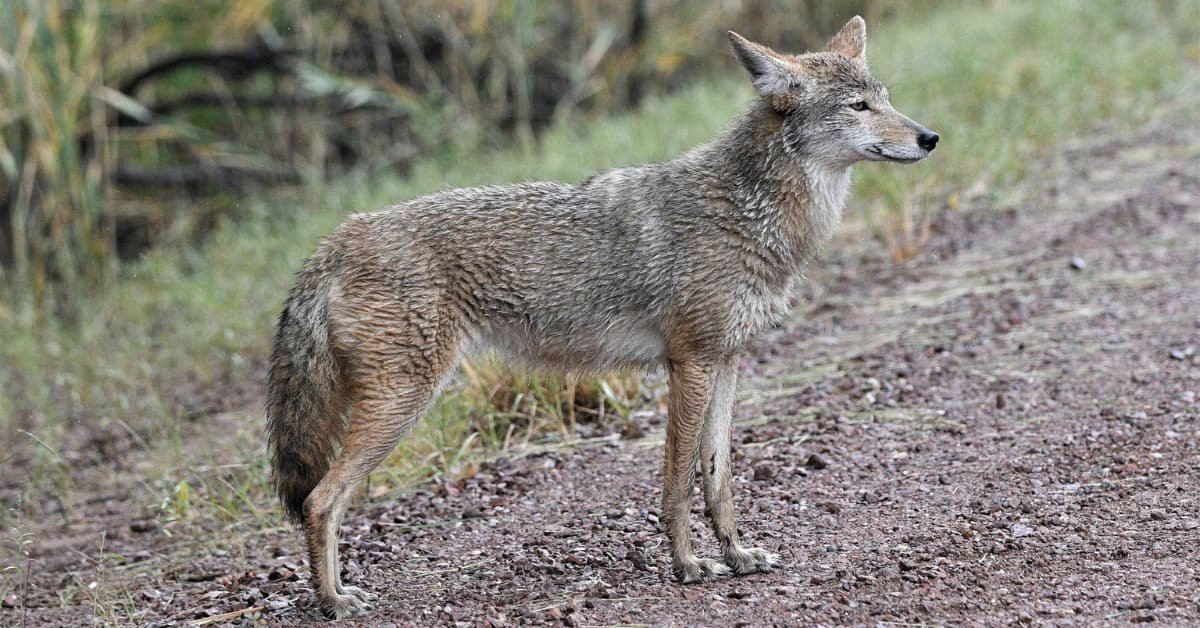
Coyotes are a common sight in many neighborhoods, and their presence can pose a threat to pets and livestock. These predators are becoming more adventurous and are known to venture into residential areas in search of food, including fallen fruit and dog feces.
While coyotes are an important part of the ecosystem, it is essential to take steps to keep them away from your yard and protect your pets from potential harm. In this article, we will discuss coyotes and dog poop! Four ways to keep coyotes away from your yard and prevent them from being attracted to dog poop.
We will explore coyote behavior and provide tips for prevention, such as cleaning up pet feces and fallen fruit. We will also discuss fencing options and other protective measures you can take to safeguard your pets. By following these guidelines, you can help ensure the safety of your pets and reduce the risk of coyote encounters in your neighborhood.
Short Summary
- Coyotes are attracted to food sources in yards, including fallen fruit and dog feces, so it’s important to clean up pet feces and fallen fruit.
- Coyotes can prey on livestock and pets, so it’s important to keep smaller dogs supervised outside, use coyote vests for smaller dogs, and keep livestock in secure pens.
- Coyotes can jump over fences and dig underneath them, so it’s important to install coyote-proof fencing that is at least six feet tall and buried at least 18 inches underground.
- Human presence can deter coyotes, so it’s important to light your yard up with motion sensor lights at night and remove tall grasses and seal potential openings where coyotes can hide.
Coyote Behavior
Coyotes, which are known to prey on livestock and pets, have become more prevalent in urban areas in recent years.
These animals are attracted to food sources like fallen fruit and dog feces in yards, which can encourage them to venture into neighborhoods in search of reliable sources of food.
Coyote hunting and urban wildlife management programs have been established in some areas to control their population and protect domestic animals.
Coyotes are opportunistic predators and have adapted to living in urban areas, where food sources are more abundant than in their natural habitat.
They are known to attack smaller dogs and cats, as well as chickens and rabbits, and are often attracted to yards that provide easy access to food and shelter.
Urban wildlife management programs employ a range of strategies to control coyote populations, including trapping, relocation, and public education campaigns to encourage residents to take measures to prevent coyotes from venturing into their yards.
Prevention Tips
Implementing measures such as cleaning up fallen fruit, using coyote-proof fencing, and installing motion sensor lights can help prevent the presence of these animals in residential areas.
Dog waste management is also crucial in deterring coyotes, as they are attracted to food sources such as pet feces. Proper disposal of dog poop can reduce the presence of these animals in residential areas.
Coyote habitat destruction is another factor that contributes to their increasing presence in neighborhoods. As their natural habitats dwindle, they are forced to search for reliable sources of food and shelter in residential areas.
Preventing the presence of coyotes in residential areas requires a combination of measures such as proper waste management, reducing potential hiding spots, and using coyote-proof fencing. By taking these steps, homeowners can protect their pets and livestock from these potentially dangerous animals.
Protection for Pets
Protecting household pets from the potential danger posed by coyotes requires implementing measures such as using coyote vests, installing motion sensor lights, and coyote-proof fencing. Coyote vests are designed to protect smaller dogs from coyote attacks by having collars made of Kevlar and spikes that deter the coyote from biting. Motion sensor lights, on the other hand, are useful in deterring coyotes from entering the yard as they disrupt the animal’s natural behavior. Coyote-proof fencing is also crucial in keeping coyotes away from the yard, and it should be at least six feet tall and buried 18 inches underground to prevent the animal from jumping or digging under it.
To further emphasize the importance of pet safety, the table below provides a summary of the different measures that pet owners can take to protect their pets from coyote attacks. It highlights the effectiveness of each measure in deterring coyotes and the potential limitations that pet owners should be aware of.
| Measures to Protect Pets | Effectiveness | Limitations |
|---|---|---|
| Coyote Vests | High | May be uncomfortable for pets |
| Motion Sensor Lights | Medium | May not work on all coyotes |
| Coyote-Proof Fencing | High | May be expensive to install |
| Supervision | Medium | May not be feasible at all times |
Overall, pet owners should be vigilant in protecting their pets from coyote attacks. While there is no surefire way to keep coyotes away, implementing measures such as using coyote vests, installing motion sensor lights, and coyote-proof fencing can go a long way in ensuring pet safety.
Fencing Options
One effective method for deterring coyotes from entering yards is by installing coyote-proof fencing that is at least six feet tall and buried at least 18 inches underground. Coyotes are known to be able to jump over fences and dig underneath them, so it is essential to make sure the fencing is secure. Coyote-proof fencing can be made from a variety of materials, including wood, metal, and PVC. It is also essential to seal any potential openings where coyotes can hide, such as gaps under gates or holes in the fence.
Here are four options for coyote-proof fencing that can help enhance backyard security:
- Heavy-duty welded wire fencing: This type of fencing is made from sturdy metal wire that is welded together, making it more difficult for coyotes to break through.
- Electric fencing: While not an option for everyone, electric fencing can be effective at deterring coyotes. It is important to follow safety guidelines and regulations when installing electric fencing.
- Chain-link fencing with a coyote roller: A coyote roller is a device that is installed on top of a fence to prevent animals from climbing over. It is typically made from PVC piping and spins freely, making it difficult for animals to gain a foothold.
- Barbed wire fencing: While not the most aesthetically pleasing option, barbed wire fencing can be effective at keeping coyotes out. It is important to use caution when installing barbed wire fencing, as it can be dangerous if not done correctly.
Conclusion
Mitigating the presence of coyotes and preventing their interaction with dog poop is essential for the safety and well-being of both humans and pets. By implementing the following four strategies, individuals can significantly reduce the risk of encounters and maintain a harmonious coexistence:
- Proper disposal of dog waste: Ensuring responsible and timely removal of dog poop from yards and public spaces is crucial. By promptly disposing of waste in designated receptacles, we eliminate a potential attractant for coyotes and minimize the likelihood of their presence.
- Encourage the use of dog waste bags: Promoting the use of dog waste bags among dog owners can go a long way in maintaining cleanliness and reducing the odor associated with dog feces. By providing convenient access to these bags in parks and popular dog-walking areas, we empower responsible pet owners to be part of the solution.
- Secure garbage and compost bins: Coyotes are opportunistic scavengers and can be attracted to unsecured garbage and compost bins. Implementing secure lids and ensuring proper closure of these containers will effectively deter them, minimizing the chances of their presence in residential areas.
- Install fencing and motion-activated deterrents: Creating physical barriers such as sturdy fences can prevent coyotes from entering properties, particularly those with small pets. Additionally, utilizing motion-activated deterrents such as sprinklers or noise devices can startle and discourage coyotes from approaching areas with dog waste.
FAQs
What is the natural habitat of coyotes?
Coyotes’ natural habitat includes open grasslands, deserts, and forests across North and Central America. However, human encroachment has led to their adaptation techniques of seeking food sources in urban areas, which has resulted in increased interactions with humans and pets.
Do coyotes hunt in packs or alone?
Coyotes exhibit both solitary and pack hunting behavior, depending on the availability of prey and other factors. Urban coyote sightings are becoming more common, with potential for coyote-human interactions. Understanding coyote behavior can aid in preventing conflicts.
Can coyotes climb trees?
Coyotes are known for their canine agility and movement, which enables them to climb trees. This behavior is observed in the wild, where they climb trees to hunt prey or escape predators. However, coyotes are not considered expert tree climbers and may struggle with larger trees or smooth surfaces.
How do coyotes communicate with each other?
Coyote vocalizations and social behavior: Exploring Communication. Coyotes use body language to convey messages and communicate through a range of vocalizations, including howls, yips, and barks. They also use scent markings to communicate with other coyotes in their territory.
Are there any natural predators of coyotes?
Preventing encounters between coyotes and their natural predators is not common as coyotes are at the top of the food chain. Effective deterrents include human presence, proper fencing, and removing food sources.



